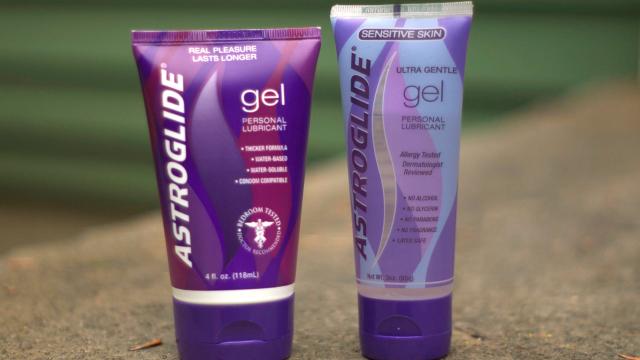It seems like practically everyone recommends personal lubricants these days. And there’s no doubt that there’s a big upside to reducing friction that can cause chafing and pain. But how do these products put slippery in a tube?
For example, BioFilm makes two versions of Astroglide water-based lubricants, Regular gel and Ultra Gentle gel for sensitive skin. The products work the same way: both are thick and stay where you put them without dribbling, both are slippery, both are safe to use with condoms. But on first read, a lot of their ingredients are very different. How do they build lubes that act fundamentally the same way during sexytime out of different materials?
Below, we’ve answered this question with a side by side comparison. The first three ingredients in both gels are nigh-identical, as they’re the source of the slippery for these products. Variation comes further down the list, with ingredients that promote stability and keep nasties from growing in the tube.
Astroglide Regular Gel vs Astroglide Ultra-Gentle Gel
Ingredient 1: Regular Gel: purified water; Ultra-Gentle Gel: purified water
The fact that the primary ingredient of these gels is water should surprise exactly no one. Their job is to reduce dryness, and they need to be edible. Water’s wet, and it’s (mostly) what we’re made of. It’s up to the rest of the stuff in the lube to keep that water where you want it, and keep it from going bad when it sits in the drawer of your bedside table for months.
Ingredient 2: Regular Gel: glycerin; Ultra-Gentle Gel: xylitol
Glycerin and xylitol are two members of the same chemical family: the sugar alcohols. Chemically, they share a family resemblance, which extends to lot of their physical properties — the important thing in lube-land is that both molecules hang on to water molecules. By slowing down the rate at which water makes its escape into the air by evaporation, these ingredients help keep lube moist and slippery longer.
Both molecules are also used as sweeteners in the food industry — and their slightly sweet taste help make the lube palatable in small doses. Glycerin allergies are rare, but xylitol can cause dangerous drops in blood sugar in dogs. If you have pets, keep the lube away from them.
Ingredient 3: Regular Gel: hydroxyethyl cellulose; Ultra-Gentle Gel: hydroxyethyl cellulose
Both lubes use a thickener made from cellulose. Hydroxyethyl cellulose molecules link up with one another when they’re dissolved in water, forming a sort of chemical net that holds water molecules in place. The end result is a thick, slippery, nontoxic goo. When the water evaporates, the cellulose gets left behind — forming that tacky film that sticks to your thighs.
Ingredient 4: Regular Gel: chlorhexidine gluconate; Ultra-Gentle Gel: aloe barbadensis leaf juice
Here’s where the products start to differ. The fourth ingredient in the Regular Gel, chlorhexidine gluconate, is an antimicrobial agent that keeps bacteria from growing in your lube. It’s an effective killer, binding to bacterial cell membranes and breaking them open. Some people are allergic to it, which is probably why it isn’t in the Ultra-Gentle gel.
In the Ultra-Gentle Gel, you find the first of the “soothing botanical ingredients” promised on the tube: some pulpy juice from the aloe plant. Like any plant product, it’s a mishmash of different chemicals, including uronic acid; sugars like glucose, mannose, and galactose; many different amino acids; and a variety of gel-forming molecules. The sugars make aloe gooey and soothing, and it’s generally safe to put on your skin (like any plant product, some people have allergies). But the jury’s still out about how much is safe to eat. A little seems to be fine, and since it’s ingredient #4, there’s probably a pretty low dose here.
Ingredient 5: Regular Gel: methylparaben; Ultra-Gentle Gel: pectin
The methylparaben in the Regular Gel kills fungus and bacteria. We can all agree that moldy lube would be a drag, but parabens can also cause skin irritation in some people — which is why the Ultra-Gentle Gel has none.
Instead, the number 5 ingredient in the Ultra-Gentle provides more gel-building action — with pectin, a complex sugar derived from plant cell walls. Pectin is also used to “set” sugar and fruit into jam, which should tell you exactly how effective they are at building water-trapping gels.
Ingredient 6: Regular Gel: glucono delta lactone; Ultra-Gentle Gel: chamomilla recutita (matricaria) flower extract
The glucono delta lactone in the Regular Gel sounds like a drink you’d get at a frat party. It’s actually a powder derived from glucose that becomes a very mild acid in water. It’s a preservative that pulls free ions out of the lube and makes it taste slightly tangy.
Yet another botanical ingredient in the Ultra-Gentle Gel — concentrated goo from chamomile flowers. Again, like any plant product, the extract contains a laundry list of molecules. Some are anti-inflammatories, others just smell nice.
Ingredient 7: Regular Gel: sodium hydroxide; Ultra-Gentle Gel: phenoxyethanol
A little sodium hydroxide in the Regular Gel buffers the acidity of other ingredients (I’m looking at you, gluconic acid), and keeps the lube at a nice neutral pH.
All those sweet botanical agents in the Ultra-Gentle Gel aren’t going to keep bacteria and mould out of it. Phenoxyethanol does the trick, killing both bacteria and molds for paraben-sensitive people. [FDA, PubMedHealth, PubChem, CIR, Paulson 1999, Budavari 2001, Dumitru 2001, Dunayer 2004, Reitschel et al. 2008, Freeman 2013]
